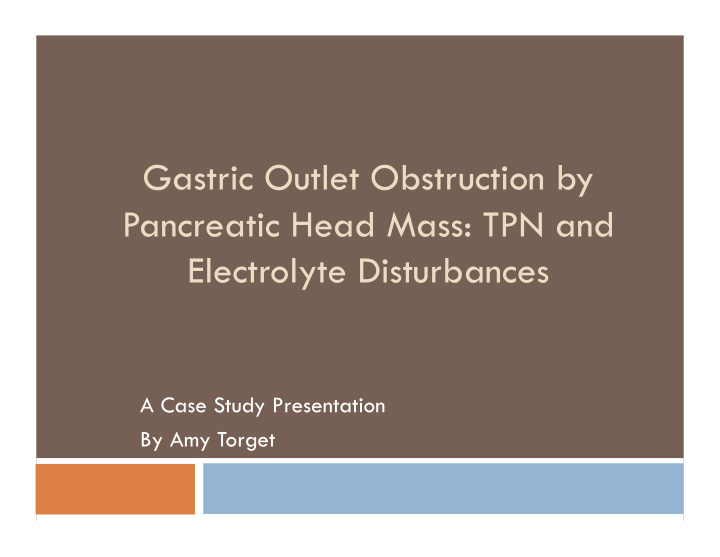



Gastric Outlet Obstruction by Pancreatic Head Mass: TPN and Electrolyte Disturbances A Case Study Presentation By Amy Torget
Introduction to Patient 62 yo male Resides in Vancouver, WA Presented to ED on 4/6 with chief complaint of abdominal pain 2 week h/o progressive abdominal pain, N/V, decreased PO intake, and jaundice Pain especially worse over 3-4 days prior to admit No UO 4 days prior to admit
Issues to be Covered History Prior to Admission ED Course Overview of GOO & Nutritional Implications Nutrition Assessment & Diagnosis Nutrition Intervention/MNT Refeeding Syndrome Electrolyte Disturbances Outcomes and Discussion
Prior to Admit Presented to PCP on 3/21 with jaundice Labs showed elevated bilirubin and liver enzymes CT scan on 3/27 showed: Pancreatic head mass associated with pancreatic and biliary duct dilation Suspicious for malignancy Pt awaiting evaluation by GI http://www.nlm.nih.gov/medlineplus/ency/article/003.html
ED Admit Presented to ED on 4/6, 10 days after CT scan Initial vitals BP of 83/37 Tachycardia Afebrile Labs Leukocytosis Elevated creatinine, BUN, lactate, CO2, blood pH Low K, Na, and Cl
ED Issues and Course Hypotension/shock 8 L NS given, systolic BP mildly responsive Central line placed, started on norepinephrine drip Started on Vancomycin and Zosyn Concern for cholangitis AKI Elevated creatinine Hypovolemia
ED Issues and Course Metabolic alkalosis Elevated CO2 and blood pH Low Cl Hypokalemia 2/2 emesis and decreased PO intake x 2 weeks Replete cautiously 2/2 AKI Check q 4 hours
ED Issues and Course NGT inserted for decompression 800 ml of water/grey fluid removed Transferred to ICU for further management of shock Hypovolemia in setting of complete GOO Septic vs. hemorrhagic shock with likely GI source
GOO Etiology Consequence of any disease that produces impediment to gastric emptying Benign vs. malignant 15-20% incidence in patients with pancreatic cancer Intrinsic or extrinsic obstruction of the duodenum is most common pathophysiology
GOO Nutrition Issues Nausea and vomiting Loss of HCl and increase in plasma bicarbonate Hypokalemic hypochloremic metabolic alkalosis Abdominal pain Dehydration Increases in BUN and creatinine Malnutrition/wt loss TPN
GOO Treatment Admit pt for hydration and correction of electrolyte abnormalities Sodium chloride IVF Potassium repletion if necessary NGT to decompress stomach Determine cause of obstruction Surgery vs. stent placement
NUTRITION ASSESSMENT
Food/Nutrition Related History 2 week history of decreased PO intake Unable to keep anything down 4 days prior to admit Diet order: NPO NPO > 6 days Outpatient Meds Lisinopril, Ranitidine, Simvastatin, Tramadol
Inpatient Drug/Nutrient Interactions Drug Indication Nutritional Implications Albuterol Anti-asthma Increased appetite, anorexia, N/V, dyspepsia, diarrhea Heparin Anticoagulant N/V, constipation, hyperkalemia Nicotine Patch Smoking N/V cessation Vancomycin Antibiotic Nausea, bitter taste Zosyn Antibiotic Dry mouth, N/V, diarrhea, anorexia
Anthropometric Measures Measurement Value Assessment Height 70 in (177.8 cm) Weight 163 lb (74.1 kg) 170 lb on 3/27 on admit Weight Change -7 lb (3.6 kg) 4% weight loss in ~10 days IBW 166 lb 98% of IBW BMI 23.4 Normal
Biochemical Data Lab Test Admit 4/6 Reference Range WBC 18.5 (H) 4.3-10.8 Lactate 8.0 (H) 0.5-2.2 BUN 56 (H) 8-25 Creatinine 3.9 (H) 0.8-1.5 Chloride 90 (L) 96-106 Potassium 2.9 (L) 3.5-5.0 Sodium 129 (L) 131-142 CO2 30 (H) 23-29 Total bilirubin 25 (H) 0.1-1.1 AST 169 (H) 10-34 Alkaline Phosphate 705 (H) 45-129 Blood pH 7.47 (H) 7.38-7.42
Nutrition Focused Physical Findings Temporal muscle: slight depression Orbital fat pad: WNL Clavicle: WNL Shoulder: slight protrusion Triceps/biceps: mild depletion Interosseous muscle: WNL Calf muscle: LE moderate edema Skin: jaundiced, poor turgor, cheilosis on lips
Malnutrition Criteria – Chronic Illness Clinical Non-Severe Malnutrition Severe Malnutrition Characteristic Energy Intake < 75% of EER for ≥ 1 month ≤ 75% of EER for ≥ 1 month Weight Loss 5% in 1 month > 5% in 1 month 7.5% in 3 months > 7.5% in 3 months 10% in 6 months > 10% in 6 months 20% in 12 months >20% in 12 months Body Fat Mild depletion Severe depletion Muscle Mass Mild depletion Severe depletion Fluid Mild Severe ( ≥ 3+ edema/ Accumulation anasarca/ascites) Grip Strength N/A Measurably reduced for age and gender
Patient History Living situation: lives alone in Vancouver, WA Social History: divorced Alcohol use: none in the past month, social drinker before then Drug use: none Family history: noncontributory Tobacco use: current smoker, 30+ pack per year history
Patient History - Medical PVD Left iliofemoral-popliteal artery occlusive disease HTN Hyperlipidemia GERD
NUTRITION DIAGNOSIS Inadequate oral intake related to 2 week progressive abdominal pain and N/V from duodenal obstruction by pancreatic mass as evidenced by pt report upon admit of poor PO intake x 2 weeks, no PO tolerance x 4 days prior to admit, NPO status since admit on 4/6 and recent 7# weight loss (4% loss of initial BW x 10 days) .
HD #1 Resuscitated with 15 L IVF (NS) in 24 hours NGT 4 L of suction within 24 hours Still hypokalemic Repletion with 20 mEq K Remains NPO (hemodynamically unstable)
HD #2 Vitals stabilized Pt off pressors/hemodynamically stable Still requiring 200 ml/hr NS K value normalized Remains NPO
Recommend
More recommend